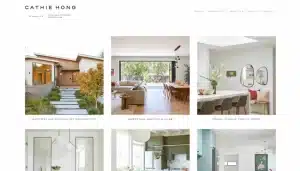What Should an Interior Design Website Include?
A well-designed and comprehensive website is essential for every interior design business or professional in the digital era. A visually appealing and user-friendly website can help you attract potential clients, showcase your portfolio, and create your brand in the competitive interior design market. So, what should your interior design website feature to stand out and effectively communicate your skills and services? Let’s get down to business, from the must-have areas to the finer points. What should an interior design website include?
1. Engaging Homepage
The homepage is your interior design website’s virtual front door. It is the first impression that visitors have, so make it count. The homepage should be aesthetically appealing, with high-quality images that match your design philosophy and style. Consider using a hero image that showcases one of your best projects, or a moving carousel of photographs to promote different design efforts.
Include a quick and compelling introduction that defines your brand’s principles, design approach, and what distinguishes you from other designers. A well-crafted tagline or phrase can help visitors remember you. Remember to include a strong call-to-action (CTA) that encourages visitors to explore your portfolio or contact you for additional information.
2. About Us Page

The “About Us” page allows you to introduce yourself or your company to potential customers. Tell your story, your background, and your journey into the field of interior design in this part. Share your love for design and the unique experiences that have impacted your career to humanize your brand.
Include professional images of yourself or your team members, as well as brief biographies highlighting each individual’s experience and contributions to the firm. Clients frequently prefer designers with whom they can connect on a personal level, so be authentic and personable in your writing.
3. Portfolio Showcase
The portfolio is one of the most important aspects of an interior design website. The portfolio section is where you may showcase your best projects and show off your design skills. Organize your portfolio into multiple categories or styles to make it easier for visitors to explore through your works.
Include high-quality photographs of each project, as well as a brief summary of the project’s aims, obstacles, and solutions. Include before-and-after photographs to show how places can be transformed, which may be quite impressive to potential clients.
4. Services Offered
Be open and honest about the interior design services you offer. List the various packages or options offered, together with their features and pricing ranges. Make sure to highlight any specialty services you provide, such as sustainable design or space planning.
Include a contact form or a call to action on this page to encourage visitors to contact you for further information or to schedule a consultation. Offering a free initial consultation is a great approach to attract new clients and demonstrate your competence in person.
5. Testimonials and Reviews
Nothing establishes trust like great feedback and testimonials from happy customers. Make a section of your website dedicated to displaying these outstanding evaluations. Include the client’s name, a photograph, and a brief testimonial about their experience working with you. To add credibility and authenticity, link these testimonials to the related projects in your portfolio.
6. Blog and Resources
Keeping a blog is an excellent approach to promote oneself as an expert in the subject of interior design. Share useful hints, design trends, case studies, and other educational stuff with your target audience. Regular blog updates also aid your website’s search engine optimization (SEO) and generate organic traffic.
Consider offering resources relating to interior design, such as e-books, design guides, or free downloadable templates. These materials can be useful inducements for visitors to sign up for your newsletter, allowing you to establish a mailing list for future marketing efforts. https://diversewebsitedesign.com.au/
7. Contact Page
The contact page is where potential clients may get all of the information they need to reach you. Include your company’s address, phone number, email address, and an inquiry form. Integrating Google Maps can also be beneficial for clients seeking for your real location.
Make sure your contact page is easily accessible from everywhere on your website. Consider including a call to action (CTA) on other sites that brings visitors to the contact page, encouraging them to contact you with any questions or design inquiries.
8. Mobile Responsiveness and User-Friendly Navigation
A flexible website is vital in today’s mobile-driven environment. Make sure your interior design website is mobile-friendly, including smartphones and tablets. A responsive website ensures that visitors have a pleasurable and smooth experience regardless of the device they are using.
User-friendly navigation is also important for keeping visitors interested. Implement simple and intuitive menus that appropriately categorize your material. Avoid overcrowding your website with too much text or too many design features that may distract or overwhelm readers.
Conclusion
Creating an effective interior design website entails more than just displaying your portfolio; it also entails interacting with your audience, developing your brand identity, and exhibiting your skills. You can design an appealing website that leaves a lasting impression on potential clients by having interesting homepage material, an informative “About Us” page, a well-organized portfolio, straightforward service options, positive testimonials, and relevant tools. To provide a seamless user experience, prioritize mobile responsiveness and user-friendly navigation. You may take your interior design firm to new heights and attract the clientele you want with a well-designed website.








